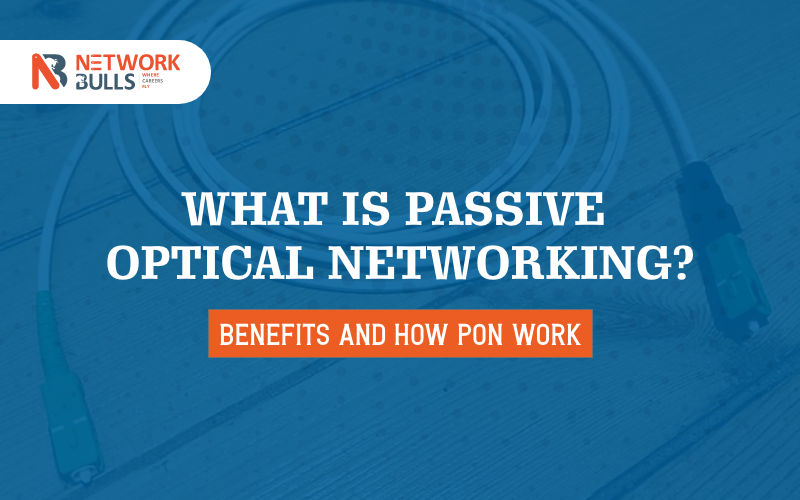What is Passive Optical Networking? | Benefits and How PON work

Passive Optical Networking (PON) is a specially designed fiber-optic system that allows a service provider to deliver broadband network access from the main data source to endpoints or end-customers. It is a fiber-optic telecommunication technology.
The topology of PON is its application of a special technology to distribute a single signal to multiple branches through unpowered devices technically termed as optical beam splitters. Telecom network providers mostly use PON.
What Is Passive Optical Networking?
As a technology, PON can be defined as (depending upon where the PON terminates) a specific system:
-
Fiber to the curb
-
Fiber building
-
Fiber to the home
Telecom network providers use PON because it brings fiber optic cabling and signals most of the way to the end users. Providing smooth Ethernet connectivity is made possible through PON from a main data center to endpoints (i.e., end users).
PON is marked by the following five main characteristics:
It is an advanced fiber-optic telecommunication technology under which the delivery of broadband network access to end-users (i.e., endpoints) is made seamless.
From the architectural standpoint, PON smoothly implements a point-to-multipoint topology. For this, a single optical fiber can serve a large number of endpoints or end-users by using unpowered or passive fiber optic splitters to divide the fiber bandwidth among the end-users or endpoints.
PON, as a scientific and technological system, is highly reliable (as compared to other networking structures) since it does not require electrically powered equipment in its path.
It can be easily installed at the Optical Line Terminal (OLT) at the central or main office of the Internet Service Provider.
The usefulness of PON can be gauged from the fact that a single fiber can be used to run through a passive optical splitter to provide a broadband connection to up to 32 Optical Network Units or Optical Network Terminals.
Benefits of PON
PON provides a large number of benefits to Internet Service Providers (ISPs) due to its built-in advantages vis-à-vis other technological systems. The five main benefits of PON are:
It can help ISPs deliver broadband triple-play services like data, voice, and video to end-users or endpoints.
It reduces the number of fiber runs required to reach a large number of end-user locations by eliminating the need to provide power to transmission devices between the central or main office of the ISPs and the endpoints.
PON is economically beneficial to ISPs as it can support multiple end-users at different locations from a single router and switch port. As ISPs use unpowered splitters to direct and dispatch data packets to end-users, it proves to be cost-effective as the comparative operational cost is much lower compared to powered systems.
PON management is straightforward. ISPs can manage it through a browser-based Graphical User Interface (GUI). MCMS allows network operators virtual control and management of active PON components.
Another major benefit is that PON reduces the requirements for climate control and the use of additional equipment needed for this purpose.
How Does PON Work?
Technologically speaking, PON as a system function seamlessly without the need for large equipment and constant power supply. The modus operandi of PON can be explained in the following way:
OLTs & ONTs: Optical Line Terminal (OLT) is a device placed at the head end (or central/main office of the ISP) of the network. A single fiber optic cable runs from the OLT to a passive or non-powered optical beam splitter. This beam splitter multiplies the signal and relays it to many ONTs (Optical Network Terminals) connected to PCs and telephones of the end-users.
Passive Optical Splitting: This is done by optical splitters. Optical splitters take a single light source and refract and duplicate it many times to outbound fibers. A single light source denotes a single fiber optic strand.
WDM & TDM: PON uses the same strand of fiber both to receive and send data. Subsequently, the passive optical splitter functions as an optical combiner receiving data packets from the same connected end devices. To function in this manner, PON utilizes two distinctive types of telephony multiplexing concepts:
-
Wavelength Division Multiplexing (WDM)
-
Time Division Multiplexing (TDM)
WDM permits bidirectional traffic across a single fiber by using a different wavelength for each direction of traffic: the 1490-nanometer (nm) wavelength for downstream traffic and the 1310-nm wavelength for upstream traffic. TDM allows multiple end devices to transmit and receive independent signals across a single fiber by reserving time slots in a stream of data.
Conclusion
PON technology is very popular among Internet Service Providers (ISPs) as it functions seamlessly. PON has proved to be cheaper to deploy compared to most other modes of broadband delivery technologies since it does not require electrically powered mid-span devices to function. Under this technology, existing fiber optics are used.
Also check
- 100% Job guarantee courses in India
- CCIE Security Course Training in India
- CCIE R&S Course Training in India
- RECOMMENDED POSTS
-
Trending (0)

-
Network Bulls Placements (53)

-
CCIE (101)

-
CCNP (32)

-
CCNA (40)

-
Awards (14)

-
Network Bulls Reviews (53)

-
Informational Articles (74)

-
Technical Articles (26)

-
CCIE Success Stories (40)

-
Summer Training Courses (5)

-
CCIE Security Version 5 (34)

-
CCIE Data Center (19)

-
MCSE (3)

-
Industrial Training (10)

-
Microsoft Certification (3)

-
Ask NB (7)

-
Network Bulls Offers (6)

-
Best Institute for CCIE Training in India (118)

-
CCIE Training Courses (78)

-
DHCP (2)

-
Webinars (6)

-
Training (128)





















